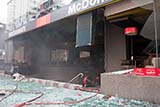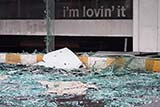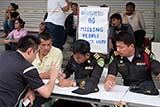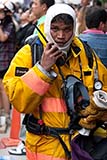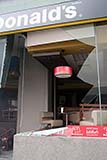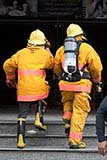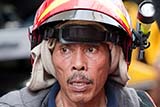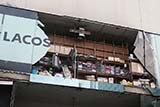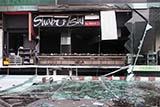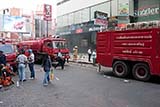Insurgency In Southern Thailand
Brief Background
Thailand's deep south - namely the provinces of Narathiwat, Yala and Pattani - has a large Muslim population. The vast majority of the Muslims are peaceful people but there are a few extremists with radical ways of thinking.
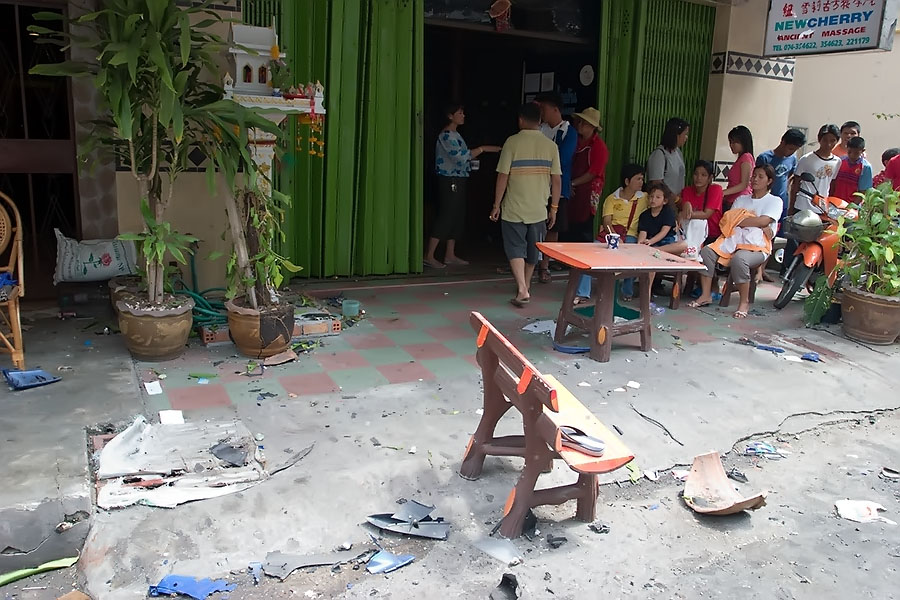
New Cherry massage parlour, Hat Yai
It is not a new problem. Problems have existed in southern Thailand for centuries. The problems in southern Thailand go back a very long way (hundreds of years) and are complex. The part of the Malay Peninsula that currently forms the southernmost Thai provinces has historically been more closely aligned with Islamic Malaysia and Indonesia than Thailand.
To start to understand the current day problems from a historical perspective it is necessary to forget about borders and countries as we define them today. The borders around Thailand were only drawn up fairly recently in historical terms.
Rather than countries or nations or states, there were independent 'power centres' or 'centres of influence'. These changed over time, there was almost constant conflict, and the most powerful centres acquired territory and people by force.
Some examples of such power centres would be Malacca, Songkhla, Nakhon Sri Thammarat, Ayuthaya, Sukothai, Chiang Mai, etc.
Islam arrived in what we now know as Malaysia in the 14th century. After the fall of Malacca to the Portuguese in 1511, the independent region of Greater Pattani (formerly part of the Sultanate of Pattani) became an important centre of trade. The people living there were of Malay ethnicity with their own distinctive culture.
By 1786 the major power centre in current day Thailand had moved to Rattanakosin (Bangkok). Previously the main power centre had been Sukothai, then Ayuthaya, but after the fall of Ayuthaya to the Burmese in 1767 it moved again.
The first ruler of the Chakri dynasty, Rama I, invaded Pattani in 1786. Pattani's ruler, Sultan Muhammad, was killed and the city destroyed. In 1821 the Siamese invaded Kedah, another one of the northern states in present day Malaysia.
The British colonialists also had an interest in Siam, as Thailand was previously known, and drew up various treaties and agreements between the two countries. In 1822 a British mission to Siam acknowledged Siamese claims to the four Malay northern states of Kedah, Kelantan, Perlis and Terengganu. In 1826 Siam became an ally of Britain and later the same year the Burney Treaty was signed. Later, in 1855, the Bowring Treat was signed between the UK and Siam.
In 1902, Pattani was formally annexed by Siam and after that came the Anglo-Siamese Treat of 1909. The 1909 Treaty transferred Kedah, Kelantan, Perlis and Terengganu from Siam to British Malaya.
When WW2 commenced, Thailand allied itself to Japan and as a reward the Japanese Prime Minister declared that Kedah, Perlis, Kelantan, and Terengganu would be returned to Thailand. Thailand took back control of these states from October 1943 until the end of the war.
Also, during WW2 the Malays fought with the British and believed that Britain would grant independence to Pattani after the war had ended.
When the war ended and Japan had been defeated the four northern states went back to British Malaya, without any independence being granted for Pattani. Those Malays who believed who believed they had an agreement with the British saw this as a betrayal.
Thailand has long had aspirations of creating a unified Thai state within its borders, with Thai as the official language, Buddhism as the official religion, and a uniform set of cultural customs. This view was obviously at odds with the many ethnic Malay Muslims who lived in the south.
The Education Act of 1921 forced Islamic schools to close and in the 1960's many Thai Buddhists from elsewhere in the country were given free land in the south, the objective being to even up the cultural diversity. This is something else that (understandably) caused resentment among the local population.
I could never condone the violence in the south, but it is easy to see why many southern Thai Muslims have issues. The land they live on has been claimed repeatedly by foreign or colonial powers that live far away. They have their own distinctive culture, religion and language and any group of people in such a position would resent a central government forcing another culture, religion and language upon them.
Some of the current inhabitants believe they are getting a raw deal from the politicians in Bangkok and there is an active separatist movement that uses acts of terrorism to try to achieve this aim. It's a complex situation and it is quite possible that extremists from other countries are supporting insurgents in Thailand to further their own causes.
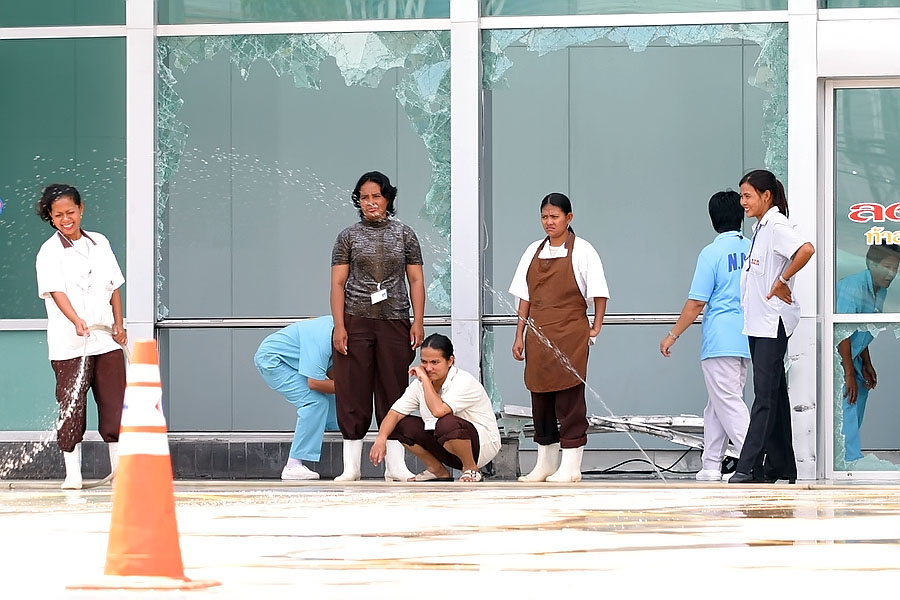
Clearing up damage after the Carrefour blast, Hat Yai
Violence flared up again after an incident in January 2004 when an army base was raided. Soldiers were killed and weapons and ammunition stolen. The following months saw an escalation of violence which eventually led to over 100 people, mainly young Muslim males armed with small knives, being gunned down on 28th April at Matsayit Kreu Se mosque, an already cursed building.
On October 25th a demonstration in Tak Bai, in Narathiwat province, resulted in about 1,000 people being arrested. Their hands were tied behind their backs and they were stacked into army trucks five deep to be taken to an army base. By the time the trucks reached their destination, 78 people had died from suffocation or crush injuries.
The Thaksin government's explanation that they died because they were weak from fasting, as it occurred during the Muslim holy month of Ramadan, was not the most sensitive of remarks to make under the circumstances. This particular incident resulted in international outrage and generated a real fear that the terrorist activities would spread to other areas of Thailand.
All through 2004 and the beginning of 2005 the problems were isolated to the three deep southern provinces and occasionally crept over the border into Songkhla. Hat Yai had been affected by terrorist activities before when a bomb went off at the railway station. The town was identified as a prime target when the violence flared up again in 2004.
One of the terrorists' aims is to damage the economy, which is why fruit plantations were destroyed and rubber tappers killed. Hat Yai, being an important commercial centre, and not too far away from the affected provinces, was always an obvious target.
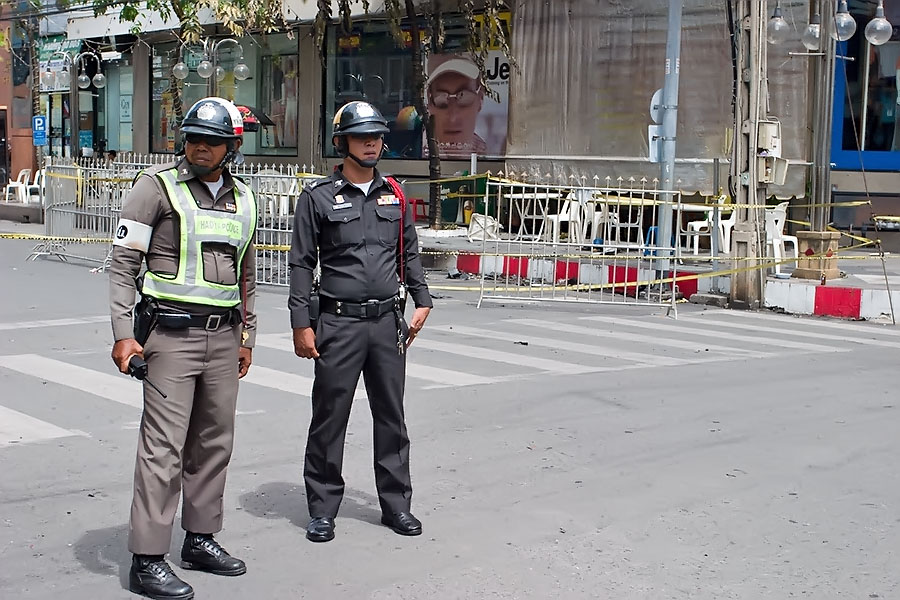
Police on the streets of Hat Yai
The authorities were quick to recognise this and put security measures in place. The centre of Hat Yai's tourist industry - Lee Gardens Plaza - was given special consideration. Motorbikes were banned from parking outside the building as they could be used to conceal an explosive device. All cars and motorbikes entering the car park were searched. At the height of the violence extra police and armed soldiers could be seen in the streets of Hat Yai.
These preventative measures worked for a long time and nothing happened, but in many ways the terrorists achieved their objective. Such was the fear of something happening that for a long time Malaysian and Singaporean tourists (the bread and butter of Hat Yai's tourism industry) stopped visiting. This wasn't helped by the Malaysian government issuing travel advisories against travelling to southern Thailand. Even though the violence didn't affect Hat Yai directly in 2004, the loss of business as an indirect result hurt the local economy badly.
On Sunday 3rd April 2005 at around 8:30pm everything changed. Coordinated attacks saw three bombs explode, two in Hat Yai and one at a hotel in Songkhla. In Hat Yai the bombs went off at the airport and at Carrefour supermarket. Three people were killed and around 60 injured including two foreign nationals at the airport.
It was the first major attack outside of the three affected provinces and a strong signal to the authorities that there could be a seriously escalation of violence. Many residents of Bangkok were getting quite concerned about the possibility of attacks occurring there.
Foreign governments issued travel advisories for tourists to stay away from Songkhla province and the lack of tourists in Hat Yai following the blasts was immediately apparent. It was heartbreaking to see so many perfectly innocent Thais made to suffer through loss of business. The weekend tourist trade, mainly from Malaysia, is the only source of income for many businesses.
Throughout 2004 the tourist numbers ebbed and flowed according to the events that took place. At the end of the year, when things were looking better, the earthquake that caused the big tsunami shook Hat Yai and that scared tourists away again. Just as everything settled down again another earthquake rocked the town and then the terrorist bombs went off.
In September 2006 more bombs went off in Hat Yai, killing five people (including a Canadian). Tourist numbers had just about recovered before the blasts but the bombs immediately had Malaysian tourists cancelling their reservations. Estimates suggested that the resultant loss of tourism revenue would be around Bt10 billion for the following year.
Hat Yai
The three affected provinces are Yala, Narathiwat and Pattani but the problems have also crept into Satun and Songkhla. Hat Yai is by far the biggest city in the south and it is an obvious target for insurgents. Some years ago, there was a blast at the railway station. When the troubles started again in 2004 the authorities immediately put measures in place to protect Hat Yai.
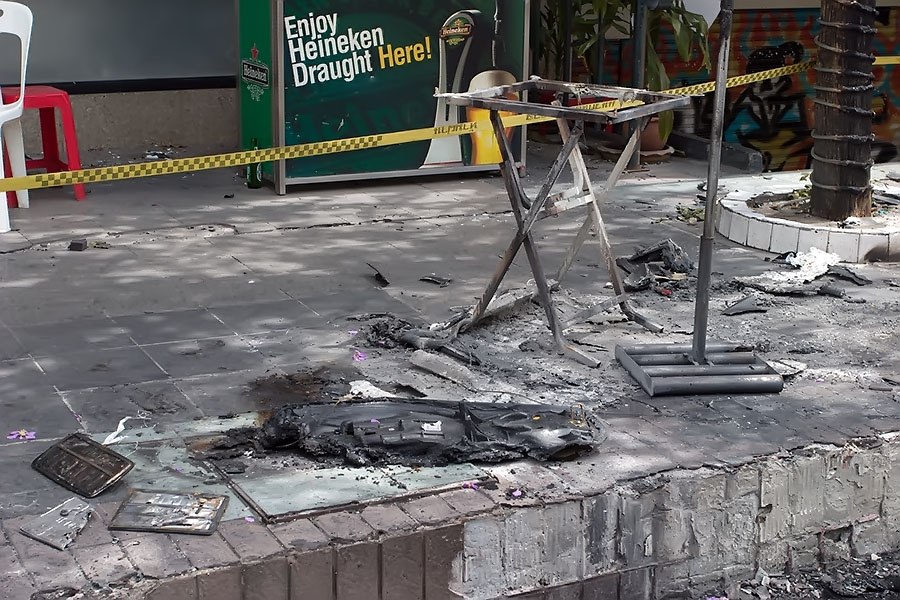
Hat Yai insurgency
Security guards were posted at every supermarket to check bags and motorcycles for explosive devices. Motorcycles were banned from parking outside certain buildings. These measures seemed to work quite well and there was only one lapse on Sunday 3rd April 2005 when three devices exploded. One was at Hat Yai airport, the second at Carrefour supermarket, and the third at a hotel in Songkhla.
The effect of the blasts was to completely decimate the weekend Malaysian tourist trade that so many locals rely on. Malaysians and Singaporeans just stopped coming. It took a good year to begin to restore confidence. When Hat Yai hotels were 100% full at Songkran 2006 it seemed as if things might be back to normal.
Saturday 16th September 2006
I got a call from my then girlfriend at 9:20pm to tell me there had been blasts downtown. She had heard them and had seen lots of people running in the street. Details were sketchy but Lee Gardens Plaza was mentioned.
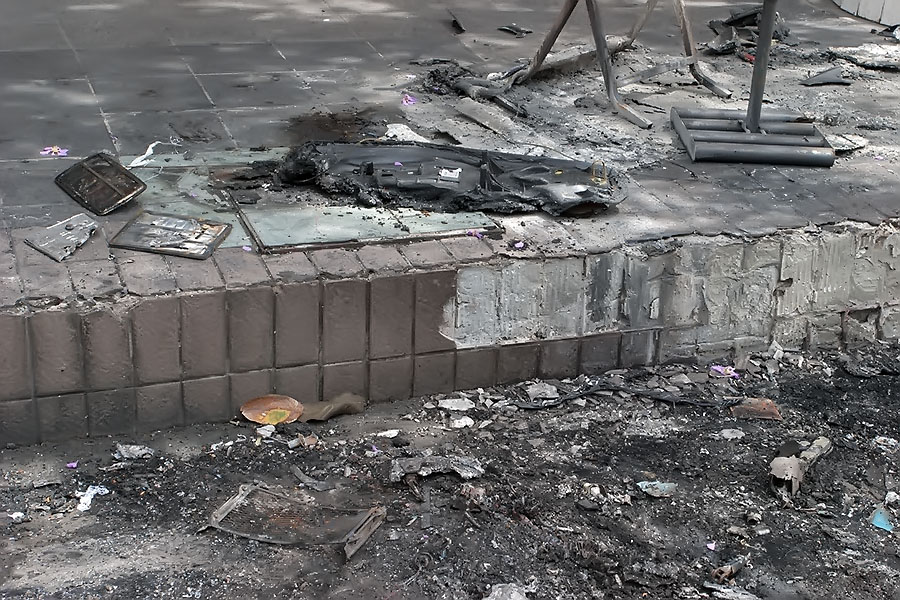
Hat Yai insurgency
She was a few hundred meters away but two devices went off within 30 meters of where she used to work. She used to spend a lot of time outside on the street trying to get customers into the shop.
Insurgents don't often seem to know what they really want, but just settle for causing havoc and disrupting life. To disrupt life in Hat Yai, blasts around Lee Gardens Plaza on a Saturday night when everywhere is jam packed with Malaysian tourists will do the trick.
Later reports said that five people had died and 50 had been injured. Various friends called me with different reports but it seemed that it had been a coordinated attack and several blasts had occurred within a short period of time.
Sunday 17th September 2006
I went to look around the affected area the morning after. A bar underneath Odean shopping centre on Thamnoonvithee Road had been hit. It looked as if the device had exploded outside and judging from the wreckage - with lots of disintegrated motorcycle parts everywhere - it looks as if it had been planted in a parked motorcycle.
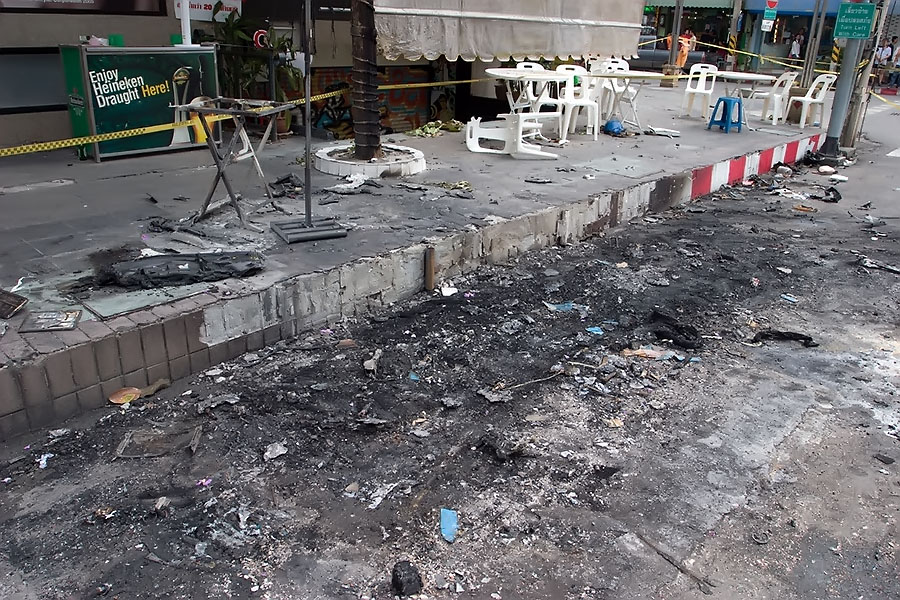
Hat Yai insurgency
Just around the corner, outside the entrance to the Odean car park was some damage to the pavement where another smaller blast had occurred. The worst damage though - and the scene of the deaths - was outside a massage parlour further along Thamnoonvithee Road. Incidentally, this area is packed full of bars and it is the main farang expat hangout in Hat Yai.
The scene outside the massage parlour was similar to outside the bar. The damage to the tarmac on the road gave an indication as to how powerful the blast was. If these devices can cause this much damage to tarmac they can kill very easily.
The first report I read said that five men who were on their way into the massage parlour were killed. I heard later that they were Malaysians. However, on Sunday morning I was told that the revised death count was four. Two Thai girls working at the parlour were killed, as well as a Canadian and a Malaysian.

Empty streets in Hat Yai after the explosions
I couldn't see any bomb damage outside Lee Gardens. I was told that there had been another blast at Diana department store but that it was relatively small and reports said that Big C was also affected.
Life in Hat Yai completely stopped temporarily. The streets were blocked off and empty. The tourists who remained took photos before they went home. There were lots of police and TV news crews around. Electricians fixed up emergency electricity supplies for the mobile TV news vans.
The Canadian killed was named later as Jesse Lee Daniel. I subsequently met a Filipino teacher who he used to work with at Ponwittaya school in Hat Yai Nai. As the deceased had no relatives in Thailand, she was asked to identify his body at Hat Yai hospital. Not a pleasant task, as you can imagine, and as a result she had trouble sleeping for weeks afterwards.
Apparently, he was inside a bar when the first explosion went off and upon hearing it he went outside to take photographs. Another bomb went off causing a piece of shrapnel to fly straight through his eye.
What Now?
Once again, the Hat Yai tourist industry will take a huge dive just as it had started to get back on track. There are thousands of Thai people working in hotels, restaurants, beauty salons and massage parlours in Hat Yai which exist only for the Malaysian and Singaporean tourist trade.
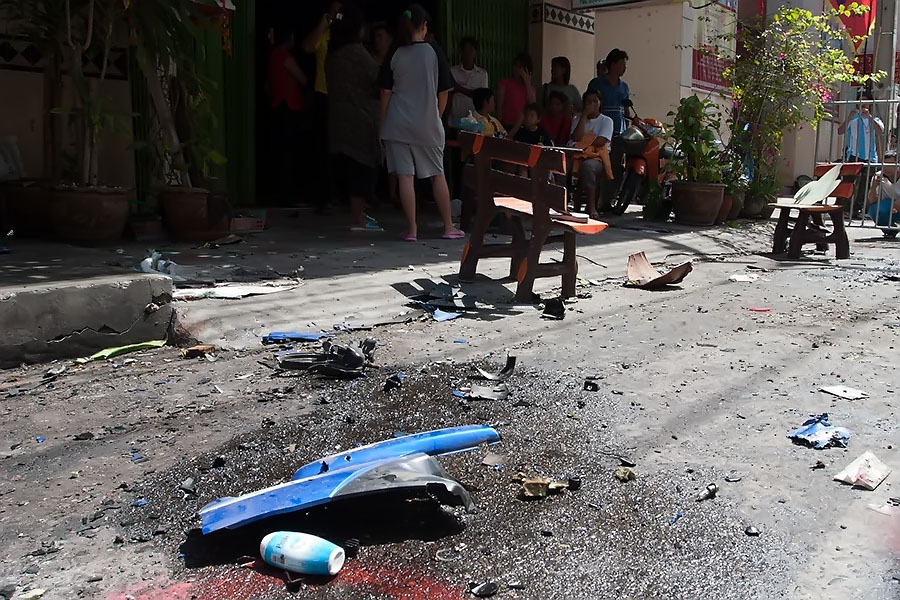
Hat Yai insurgency
Many Thais from elsewhere in the country have moved to Hat Yai to support this industry. Go to any massage parlour in Hat Yai and you will find that most of the workers are from the north and north-east.
Most, but not all, of the workers are girls and they live frugal lives many miles away from their families so that they have money to send back home. These latest blasts in southern Thailand will have far-reaching consequences hundreds of miles away.
The Solution
Well, if I knew the answer I would probably be getting a Nobel peace prize but sadly I don't. All I do know is that these crude devices are very easy to make from easily available materials. They can be placed in a motorbike and detonated by a timer or mobile phone.
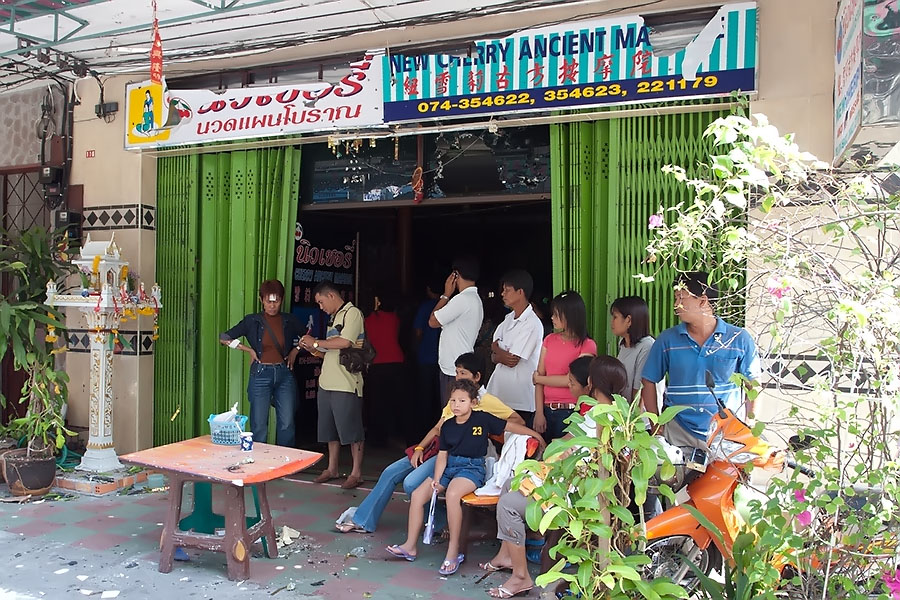
Hat Yai insurgency
You can check motorbikes going into buildings but you can't check every motorbike being parked on the street. It is just impossible. Trying to prevent people from setting bombs off with mobile phones is also impossible.
It is a requirement to register your mobile phone now but evil people will always find a way to get around such restrictions. All they have to do is steal a phone, or steal someone else's ID and use it to make a false registration.
If insurgents are determined enough, there isn't a lot we can do. What needs to happen is for governments to completely change their way of thinking. This isn't something you can fight against, especially with suicide bombers who don't care about losing their own lives.
Dialogue is the only way. I am still not clear about what it is the terrorists actually want so asking their representatives that question would be a good starting point. What they want is probably unattainable, and it would also probably be economic suicide, but knowing the answer would be a good starting point.
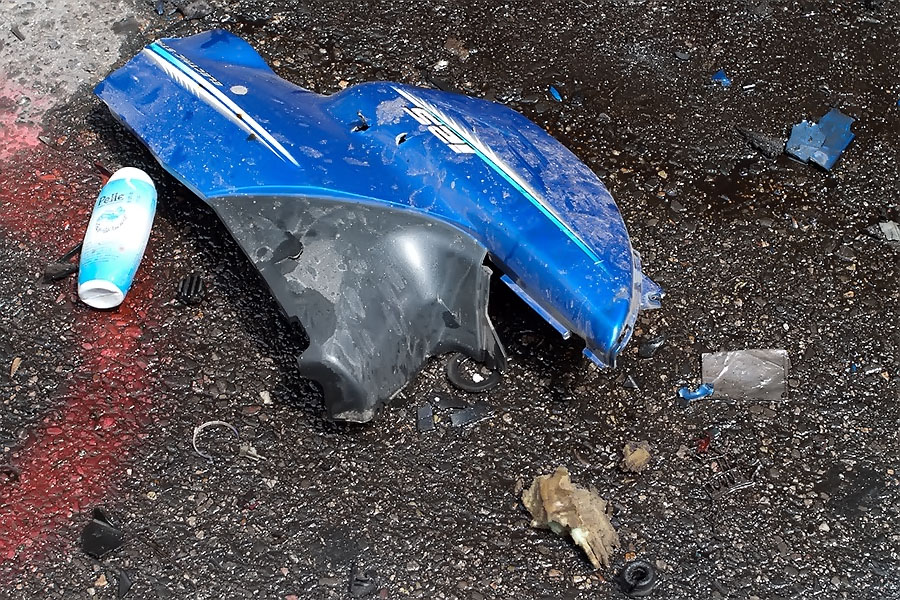
Motorcycle debris from the Hat Yai insurgency
This evil killing can never be condoned but the terrorists must have grievances. A strength of the Thai people is being able to compromise and to find ways to make both parties involved in a dispute happy without confrontation. This is what needs to happen now. Trying to prevent reoccurrences won't work and going in heavy-handed (as happened before under Thaksin) will only make things worse.
Inevitably, the question will be raised regarding how safe Hat Yai is from terrorist attacks now and I would like to look at it logically without any emotion. In this most recent attack there were six blasts and last year there were two (the third was in Songkhla). It is almost three years since the problems flared up again so let's say, on average, there have been three explosions a year.
The motorcycle bombs yesterday had an effective radius of 20m so a quick Πr2 tells me that the danger area was about 1,256m2 for each one, or 3769m2 for three.
Hat Yai is a pretty big place so what are the chances of you being in any one of three 1,256m2 danger areas at exactly the time the bomb goes off? If you walk past 30 seconds before or after it won't affect you; you have to be in exactly the wrong place at exactly the wrong time. I don't know how to work this out statistically but the odds are pretty long.

Standard Hat Yai check for motorcycle bombs
However, this is not how people think and they get carried away by emotion. People worry about terrorist bombs but not about road accidents, which are far more likely to injure you in Thailand than anything else.
People don't worry about diseases which kill millions of people each year, such as malaria, but they cancel travel plans because of bird flu which kills a handful of people each year.
The effects have been immediate. Later in the day I went to Carrefour which is normally packed solid at weekends, as are the other big supermarkets. Thais like to hang out at these places, not least because they are air-conditioned. It was pretty deserted.
On this occasion, two big shopping centres were targeted, as was Carrefour last year. They are primary targets and just like last year after the Carrefour blast, the locals stopped going because they were afraid. After the blast last year I was told to avoid supermarkets and already people have been giving me the same advice.
Not that I will be heeding it. I worked in London during the IRA terrorist campaign and my attitude is that terrorists will not alter the way I live my life.
Saturday 31st March 2012
On Saturday 31st March 2012 there were coordinated car bomb attacks in Yala and Hat Yai. Eleven people were murdered in Yala, and three in Hat Yai. Many others were injured. Sahudin Tohjehmah is suspected of being the mastermind behind the group of insurgents responsible for these atrocities.
Suspects identified : Security officials
Muslim extremists in southern Thailand seem to regard Lee Gardens Plaza as their very own New York World Trade Center.
"An independent analyst who asked not to be named - said the car laden with explosive was parked on level four of the hotel's five-storey underground car park on purpose. He said the attackers wanted to use fuel in more than 100 cars to multiply the blast, to try to weaken the hotel's structure and possibly cause it to collapse."
In Hat Yai a huge explosion occurred in the basement carpark of Lee Gardens Plaza. My sister-in-law heard the explosion from about 3 kms away. Clouds of black smoke could be seen billowing out of Lee Gardens Plaza, which of course was packed with the usual Saturday afternoon crowds.
Unable to exit the building, many people suffered from smoke inhalation and some tried to escape from windows precariously descending flimsy ladders.
McDonalds restaurant was destroyed and many other businesses put out of action. I had eaten at McDonalds two days previously.
Initially, the authorities stated that the explosion was caused by an underground gas tank and that it wasn't related to the Yala attacks. However, forensic evidence discovered later confirmed that the blast had been caused by a car bomb.
Prior to the blast, tourism authorities in Hat Yai had been preparing for the annual Songkran festival and they were planning additional activities to encourage more tourism. Immediately after the blast, 60% of hotel reservations were cancelled.
The chairman of the Songkhla tourist board estimated that it would take three months for the situation to get back to normal. I thought he was being optimistic. Apparently, Hat Yai's mayor thought the same as me and was quoted as saying it will take two years.
Steps urged to ease tourists' fears after South attacks
The bomb was planted in a stolen car and the police were concerned that insurgents may have been planning further attacks in four other stolen vehicles.
Alert for car bombs in the South
Blame has been apportioned, but it's an almost impossible task for the authorities. Hat Yai is a busy place and although there are security guards, police and soldiers around, insurgents will always find a way through the defences.
Senators criticise govt for poor intelligence operations
The authorities could make everywhere completely safe, but in order to keep out a handful of bad people they would cause terrible inconvenience to thousands of good people. It's very difficult.
Terrorists 'exploit poor coordination'
What I find most disturbing of all is that no one seems to know what the insurgents want, or how to deal with the problem.
"A source close to the Southern Border Provinces Administrative Centre said yesterday that escalated violence was aimed at sending signals that insurgents do not want to negotiate with authorities."If they don't want to negotiate and no one knows what exactly they want, how can the problem be solved?
South strategy an utter failure
Personally, I have never in the past let terrorists alter my way of life. I carried on as normal in London during the IRA campaign, and I have gone about my business as usual in Hat Yai despite the problems.
Now, however, I have a baby daughter and she goes wherever my wife and I go. I don't fear for myself, but I fear for her and I could never forgive myself if I took her to a place where she was harmed.
I will still visit central Hat Yai and Lee Gardens Plaza, but perhaps not as often as before, and perhaps not with my family.
Here are some photos I took a few hours after the blast. Click on a thumbnail to view a larger image. Please remember that all images on this site are protected by copyright.
What next? As the commentator in the following link says, Hat Yai is a resilient city and will bounce back. He goes on to say, "It will pull through, but maybe it will take a bit longer this time around."
I think that is a very accurate assessment.
PM's visit to Hat Yai belated, but welcome
Cost of Hat Yai hotel attack put at Bt1.5 bn to Bt2.6 bn
Security In Hat Yai
As you can probably guess, security is quite tight in Hat Yai. Most of the big department stores have security guards on the doors checking bags and some have airport-type scanners that visitors must walk through. The same is also true of Hat Yai railway station. Train stations and railway lines have been a favourite target of insurgents.
Car park security is also quite strict. To enter any car park, drivers must show their National ID card or driving licence and it is scanned in. Security guards check car boots (trunks) and at some places they use mirrors to check the underside of cars for explosive devices. Some car parks prohibit vehicles that run on LPG fuel. Many vehicles in Thailand have been converted to run on LPG.
On several occasions insurgents have concealed bombs in parked motorcycles. There are signs in Hat Yai town centre that parked motorbikes should have their seats left unlocked so that police can check inside for anything suspicious.
Thai intelligence sources are quite good and there are certain times when more police and soldiers suddenly appear on the streets in anticipation of potential problems. Certain dates are significant because of past events and there is a higher risk of insurgent activity on these dates.
It's not always convenient, but it's a small price to pay for security and peace of mind. Be aware of potential problems, but don't overly concern yourself.
I have lived in Hat Yai permanently since 2003 and I live a perfectly normal life without any fear of insurgency. I worry far more about the dangers posed by insane Thai drivers than I do insurgents.
There have been just a couple of occasions when there has been a lot of insurgent activity and I have chosen to stay away from the town centre temporarily. Thais I have spoken to from elsewhere in the country seem to think that terrorist incidents occur daily in this part of Thailand and that it is a big problem, but really it isn't.
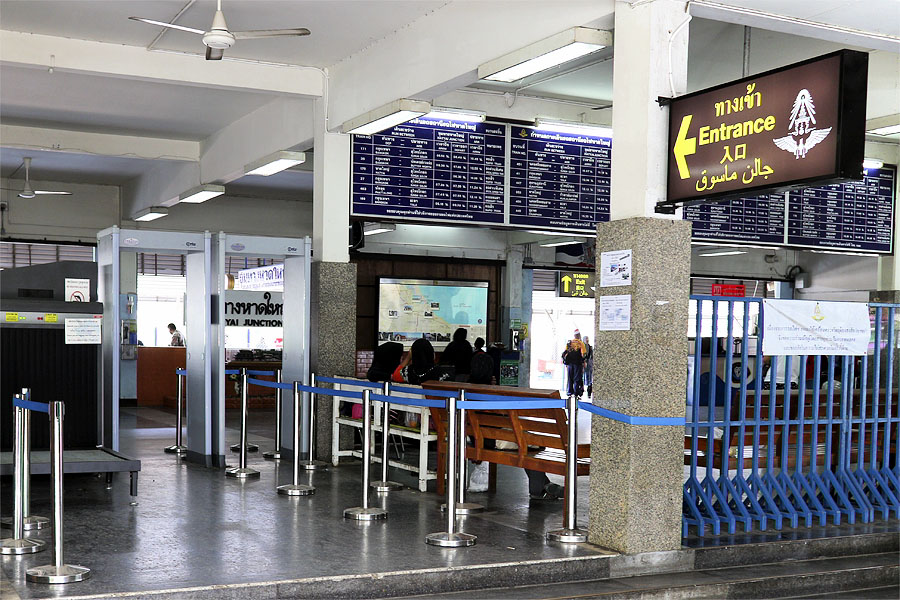
Airport type security at Hat Yai train station


